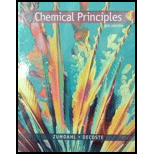
Concept explainers
Interpretation: The concentration of
Concept Introduction: The relationship between reactants and products of a reaction in equilibrium with respect to some unit is said to be equilibrium expression. It is the expression that gives ratio between products and reactants. The expression is:
Answer to Problem 125CP
The concentration of
Explanation of Solution
Given:
The reaction for the formation of
The value of formation constant is calculated as follows:
From the large value of
For obtaining ICE table, the concentration of the reactants involved in the formation of
Substituting the values:
Molar mass of Mg 24.3 g/mol
Molar mass of
The mole ratio of
Thus, the limiting reagent is
So, the ICE table for the formation of
Solving for the backward reaction:
The expression for the formation constant is:
Substituting the values:
Since
Hence, the concentration of
Want to see more full solutions like this?
Chapter 18 Solutions
CHEM.PRINC.W/OWL2+REBATE+2 SUPPL.>IP<
- The deltaHs of cobalt (II) nitrate is +47.7 kJ/mol. What is the deltaHf of solid cobalt (II) nitrate? deltaHf(NO3-(aq)) = -205.00 kJ/mol deltaHf(Co2+(aq)) = -58.2 kJ/molarrow_forwardThe Ksp of PbCl2 is 1.6*10^-8. If 1M solution of NaCl is added to a saturated solution of PbCl, how will the concentration of dissolved Pb in the solution be affected?arrow_forwardKsp for Pb(IO3)2 is 2.5x10-13. What weight of Pb(IO3)2 will dissolve in 200 mL of water?arrow_forward
- 36 I. FilteringII. EvaporationIII. Magnet zoomIV. Dissolving in waterIn what order should the above processes be applied to separate a mixture of iron powder, naphthalene and table salt into its components? a) II, III, I, IV B) IV, I, III, II NS) IV, III, I, II D) III, IV, I, II TO) III, IV, II, Iarrow_forwardProvided the reaction A + 2B + C → 2D + E, and the set of data thatfollows:arrow_forwardcalculate Kc for the reaction PCl5 = PCl3 + Cl2 at 500K, if at equilibrium moment 54% of PCl5 is dissolved, and the initial concentration of PCl5 was 1Marrow_forward
- The Ksp of Al(OH)3 (MM: 78) is 1.90 xx 10^(-33). a) What is the solubility of Al(OH)3 in g/L?arrow_forwardIf the concentration of Sn2+ ions in a solution of Sn(OH)2 was measured to be (1.24x10^-3), what is the Ksp value for Sn(OH)2?arrow_forwardThe Ksp of Fe3(PO4)2 is 5.51⋅10-21 M. Calculate the solubility of Fe2+ and PO43- in a saturated solution.arrow_forward
- It is found that 8.70e-09 g of Ga(OH)3 dissolves per 100 mL of aqueous solution at 25 oC. Calculate the solubility-product constant for Ga(OH)3.The Ksp of Y2(CO3)3 at 25 oC is 1.03e-31. What is the molar solubility of Y2(CO3)3?arrow_forwardFor a reaction where Rate = k[CV]1[OH]0, what would be the effect of halving the hydroxide ion concentration while doubling the crystal violet concentration?arrow_forwardThe solubility of silver chloride is 1.3 x 10-5 mol L-1. What is the Ksp for silver chloride at 25 °C?arrow_forward
 Introduction to General, Organic and BiochemistryChemistryISBN:9781285869759Author:Frederick A. Bettelheim, William H. Brown, Mary K. Campbell, Shawn O. Farrell, Omar TorresPublisher:Cengage Learning
Introduction to General, Organic and BiochemistryChemistryISBN:9781285869759Author:Frederick A. Bettelheim, William H. Brown, Mary K. Campbell, Shawn O. Farrell, Omar TorresPublisher:Cengage Learning Chemistry & Chemical ReactivityChemistryISBN:9781337399074Author:John C. Kotz, Paul M. Treichel, John Townsend, David TreichelPublisher:Cengage Learning
Chemistry & Chemical ReactivityChemistryISBN:9781337399074Author:John C. Kotz, Paul M. Treichel, John Townsend, David TreichelPublisher:Cengage Learning

